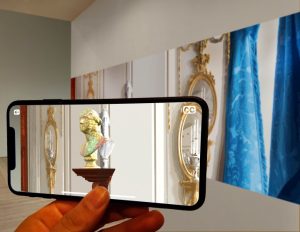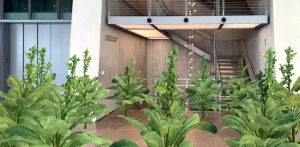The exhibit Alan Michelson: Wolf Nation was hosted at the Whitney Museum of American Art in Manhattan, intended to highlight the effects of colonization in creatively provocative ways: the first image below shows the AR interaction titled “Town Destroyer” (2019), which occupies a long hallway and simulates a panoramic feeling and is activated by AR (Rina, 2019).

Alan Michelson with Steve Fragale, “Town Destroyer” (2019), wallpaper and augmented reality, with video, color, sound; 5:57 min. Sound by members of Six Nations of the Grand River Territory (all images courtesy of the Whitney Museum of American Art)
In the absence of AR, viewers see a white bust of George Washington at his Mount Vernon estate; when viewing it through the app however, the image becomes three-dimensional with colonial maps, site markers, historical documents, etc. that illustrate his more truthfully destructive legacy (Rina, 2019).
Another major work in the exhibit is “Sapponckanikan (Tobacco Field) (2019), which is the first one viewers see upon entering the museum:

Alan Michelson with Steve Fragale, “Sapponckanikan (Tobacco Field)” (2019), augmented reality
Through the app, viewers can see a ‘portal’ opening on their cellphone screens to the same location 400 years prior: the museum’s lobby becomes filled with tall tobacco plants experiencing their seasonal cycles (Rina, 2019).
The exhibit brilliantly employs the “surface level” viewing of its works to mirror Western revisionist history that can be easily taken for granted to be true. This is juxtaposed to the much more nuanced and even darker truths that the AR app for the exhibit reveals. As Rina (2019) states in her article, the exhibit also layers time and space to convey the resilience of North American Indigenous people by asserting that they were and still are here.
References
Rina, A. (2019, December 23). Highlighting the Resilience of Indigenous People Through Augmented Reality. Hyperallergic. https://hyperallergic.com/530443/highlighting-the-resilience-of-indigenous-people-through-augmented-reality/
Amy.. I am loving these posts! I found a similar example of layering time and space with a gaming example out of Australia (it is my M3-P1). It’s called Virtual Songline and it takes the current landscape of the Sydney Harbour and layers the Indigenous landscape pre-European settlement. These AR examples are so cool.
Thanks so much, Mandy! I’ve come across Virtual Songline was well, and it’s definitely something to behold. The more I research this topic, the more intrigued I become!